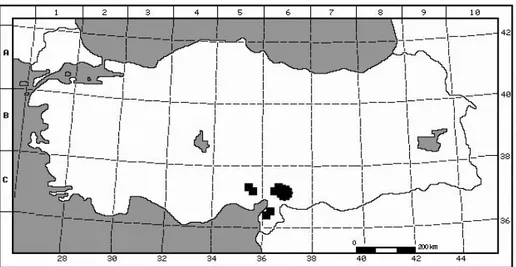www.biodicon.com Biological Diversity and Conservation
ISSN 1308-8084 Online; ISSN 1308-5301 Print 4/3 (2011) 44-51
Research article/Araştırma makalesi
Cicer floribundum var. amanicola (Fabaceae), a new variety from south Anatolia, Turkey
Meryem ÖZTÜRK
*1, Ahmet DURAN
1, Erdoğan E. HAKKI
21
Selçuk University, A.K. Education Faculty, Department of Biology Education, 42090 Meram-Konya, Turkey
2
Selçuk University, Agriculture Faculty, Department of Soil Science and Plant Nutrition, 42075, Selçuklu-Konya,
Turkey
Abstract
A new variety, Cicer floribundum Fenzl. var. amanicola M.Öztürk & A.Duran is described from southern
Turkey. The variety grows clearing of Pinus nigra forest (C6 Osmaniye province). C. floribundum var. amanicola, an
endemic confined to south of Anatolia, is related with C. floribundum var. floribundum. Diagnostic morphological
characters from C. floribundum var. floribundum are discussed and arranged in a key. Notes are also presented on its
ecology and conservation status. In addition, pollen characteristics and seed coat surface features are examined with
SEM. The geographical distributions of taxa are given in a map.
Key words: Cicer, Leguminosae, palynology, morphology, Turkey
--- * ---
Cicer floribundum var. amanicola (Fabaceae), Güney Anadolu’dan yeni bir varyete
Özet
Türkiye’nin güneyinden Cicer floribundum Fenzl. var. amanicola M.Öztürk & A.Duran olarak yeni bir varyete
tanımlandı. Bu yeni takson, Pinus nigra orman açıklıklarında yetişir (C6 Osmaniye). C. floribundum var. amanicola,
endemik olup C. floribundum var. floribundum taksonundan ayrılır. C. floribundum var. amanicola ile var. floribundum
taksonlarının tayin anahtarı düzenlendi ve ayırıcı karakterlerinin karşılaştırmaları yapıldı. Ayrıca ekolojisi verildi ve
tehlike katergorisi önerildi. Bunlara ilave olarak polen karakterleri ve tohum yüzey özellikleri elektron mikroskobu
(SEM) ile çalışıldı. Taksonların coğrafik dağılımları harita üzerinde gösterildi.
Anahtar kelimeler: Cicer, Leguminosae, palinoloji, morfoloji, Türkiye
1. Introduction
The genus Cicer L. comprises 45 species which has 9 annuals and 35 perennials (van der Maesen et al., 2007,
Dönmez, 2011). Coles et al. (1998) were reported that the diversity centre of the Cicer genus is south-western Asia.
Also, endemic species found in Morocco and the Canary Islands (van der Maesen,1987; Davies et al., 2007).
Cicer species represented with 10 species in Flora of Turkey (Davis, 1970; Davis et al., 1988). The genus
Cicer taxa are distributed especially in Southern, South Eastern, Eastern, Mediterranean and Aegean part of Turkey. In
addition to these taxa C. heterophyllum Contandr., Pamukç. & Quezel and Cicer uludereensis Dönmez were introduced
to scientific world for the first time (Contandriopoulos et al., 1972; Dönmez, 2011). In this paper, we add a further
variety, raising the total number of Cicer taxa known from Turkey to 13. Cicer echinospermum P.H.Davis, C.
floribundum, C. isauricum P.H.Davis, C. heterophyllum, Cicer uludereensis and C. reticulatum Ladiz. are endemics for
Turkey (Davis, 1970; Davis et al., 1988; Contandriopoulos et al., 1972; Dönmez, 2011).
Cicer, the only genus in tribe of Cicereae, its greatest diversity in West and Central Asia with an extension to
the Mediterranean region (the Middle East, East Europe, and an isolated area in North Africa), but its origin and
*
Corresponding author / Haberleşmeden sorumlu yazar: Tel.: + 9003323238220-5878; Fax.: + 9003323238225; E-mail: mrymztrk@gmail.com



